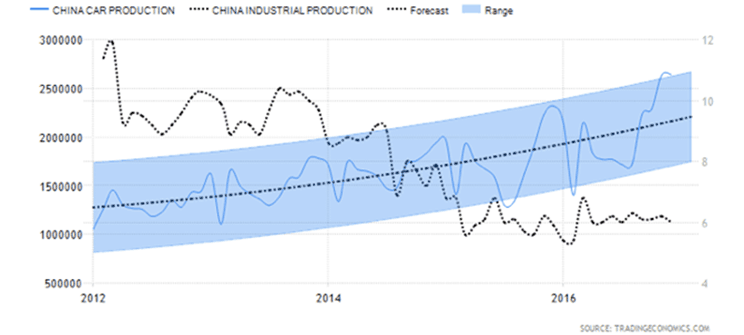Navigating The Complexities Of The Chinese Automotive Market: Case Studies Of BMW And Porsche

Table of Contents
Understanding the Unique Landscape of the Chinese Automotive Market
Market Size and Growth Potential
The sheer size of the Chinese car market is staggering. In recent years, annual sales have consistently exceeded 20 million units. Projected growth in the coming years, fueled by a burgeoning middle class and increasing urbanization, promises continued expansion. Key market segments, such as:
- Luxury vehicles: This segment experiences robust growth, attracting premium brands like BMW and Porsche.
- Electric vehicles (EVs): Government incentives and increasing environmental awareness are driving significant growth in the China EV market.
- SUVs: The popularity of SUVs continues to soar, accounting for a large percentage of overall sales in the Chinese automotive industry.
These trends underscore the significant growth potential within the Chinese automotive market and the need for adaptable strategies. The Chinese car market size presents both lucrative opportunities and substantial competition.
Government Regulations and Policies
Navigating the Chinese automotive market requires a deep understanding of its complex regulatory environment. Government policies significantly influence the industry, including:
- Stringent emission standards: China is actively pushing for cleaner vehicles, impacting vehicle design and technology.
- New Energy Vehicle (NEV) incentives: Government subsidies and preferential policies are accelerating the adoption of electric and hybrid vehicles. NEV policy China is a key factor to consider.
- Import tariffs and quotas: These can significantly impact the pricing and availability of imported vehicles.
Understanding and adapting to China automotive regulations is critical for foreign automakers to succeed. This includes staying updated on changes in Chinese government auto policy.
Consumer Preferences and Trends
Chinese car buyer preferences are diverse and evolving. Understanding these nuances is paramount for effective marketing. Key trends include:
- Brand loyalty: While established brands hold sway, younger consumers show increasing openness to new entrants.
- Technology adoption: Chinese consumers are early adopters of technological advancements in vehicles, demanding advanced features and connectivity.
- Emphasis on safety and reliability: These remain critical factors influencing purchasing decisions in the Chinese car market size.
- Growing preference for SUVs and EVs: reflecting global trends but with its own unique characteristics based on Chinese consumer trends automotive.
The luxury car market China is highly competitive, demanding sophisticated marketing strategies that resonate with specific consumer preferences.
BMW's Strategy in the Chinese Automotive Market: A Case Study
Localization and Customization
BMW's success in China is partly attributable to its commitment to localization. This includes:
- Developing specific models and features: Tailoring vehicles to meet the preferences of Chinese consumers.
- Localized marketing campaigns: Crafting marketing messages that resonate with the Chinese culture. BMW marketing China has been notably successful in this area.
While challenges exist, BMW's localization strategy has been a key factor in their successful penetration of the Chinese automotive market. BMW localization efforts showcase the necessity of understanding the local context.
Production and Supply Chain
BMW's significant manufacturing presence in China, through joint ventures and wholly-owned facilities, has:
- Reduced production costs and improved delivery times.
- Enhanced market responsiveness and facilitated quicker adaptation to local demands.
Managing a supply chain within China presents complexities, but BMW's integrated approach has provided a competitive advantage in the Chinese automotive supply chain. BMW China manufacturing demonstrates a commitment to local production.
Porsche's Approach to the Chinese Automotive Market: A Case Study
Targeting the Luxury Segment
Porsche has successfully focused on the high-end luxury segment in China, capitalizing on:
- Brand prestige and exclusivity: Porsche's brand resonates with affluent Chinese consumers.
- Targeted marketing efforts: Porsche marketing China highlights exclusivity and performance.
Porsche China strategy demonstrates a clear understanding of the luxury cars China market and its specific clientele.
Digital Marketing and Brand Building
Porsche leverages digital channels and social media effectively, building brand awareness and fostering engagement with:
- Targeted online advertising campaigns: Reaching specific demographics and fostering brand loyalty.
- Engaging social media content: Connecting with consumers on platforms popular in China. Porsche digital marketing China showcases the importance of digital strategies in this market.
Porsche brand building China involves creating a strong online presence and active engagement with potential customers. China social media marketing automotive is crucial to Porsche's success.
Conclusion: Navigating the Future of the Chinese Automotive Market
The Chinese automotive market presents both significant challenges and immense opportunities. BMW and Porsche's case studies illustrate the importance of localization, understanding consumer preferences, and adapting strategies to this dynamic environment. To succeed in this competitive market, thorough research and a well-defined strategy are crucial. Understanding local regulations, like NEV policy China, is essential. Begin your exploration of the Chinese automotive market today! The potential rewards for those who successfully navigate the complexities of this market are substantial. Mastering the Chinese automotive market requires a deep understanding of its unique nuances.

Featured Posts
-
 Family Film Casting News Mia Wasikowska And Taika Waititi
May 21, 2025
Family Film Casting News Mia Wasikowska And Taika Waititi
May 21, 2025 -
 Alles Over Tikkie De Ultieme Gids Voor Het Nederlandse Betalingssysteem
May 21, 2025
Alles Over Tikkie De Ultieme Gids Voor Het Nederlandse Betalingssysteem
May 21, 2025 -
 Increased Storm Risk Overnight Severe Weather Possible Monday
May 21, 2025
Increased Storm Risk Overnight Severe Weather Possible Monday
May 21, 2025 -
 Updated Trans Australia Run World Record Attempt Update
May 21, 2025
Updated Trans Australia Run World Record Attempt Update
May 21, 2025 -
 Scrutinizing Trumps Aerospace Contracts A Deep Dive Into The Data
May 21, 2025
Scrutinizing Trumps Aerospace Contracts A Deep Dive Into The Data
May 21, 2025
